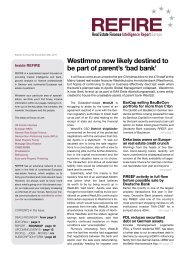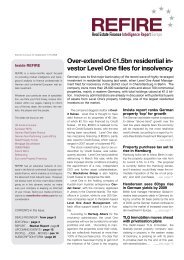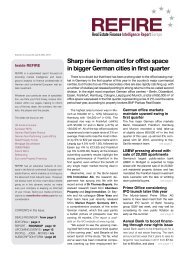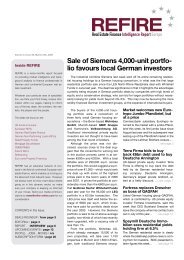Interview: James Bauer, Managing Director, REAG - Five reasons to ...
Interview: James Bauer, Managing Director, REAG - Five reasons to ...
Interview: James Bauer, Managing Director, REAG - Five reasons to ...
You also want an ePaper? Increase the reach of your titles
YUMPU automatically turns print PDFs into web optimized ePapers that Google loves.
REFIRE Series<br />
German Market Report:<br />
S<strong>to</strong>rage and Logistics<br />
Property<br />
S<strong>to</strong>rage and logistics properties account<br />
for around 840 million sq.m.<br />
of Germany’s 1.9 billion<br />
sq.m. of commercial and<br />
industrial space, and demand<br />
for logistics facilities<br />
has increased strongly in<br />
recent years, according <strong>to</strong> a report by<br />
Düsseldorf-based AENGEVELT-RE-<br />
SEARCH. Around 8.5 million sq.m.<br />
of space is added <strong>to</strong> the sec<strong>to</strong>r each<br />
year.<br />
Inves<strong>to</strong>r demand for logistics properties<br />
has continued <strong>to</strong> increase in recent<br />
years. The <strong>to</strong>tal transaction volume for<br />
commercial and industrial properties<br />
reached about �€8.9 billion in 2006, up<br />
around 60% on the previous year, with<br />
approximately a third of this figure being<br />
accounted for by logistics properties.<br />
AENGEVELT predict that the <strong>to</strong>tal<br />
transaction volume in the commercial/<br />
industrial sec<strong>to</strong>r will be around €�12<br />
billion in 2007 but, while 2006 was a<br />
boom year in logistics property, 2007<br />
will see more modest<br />
advances.<br />
About 1.8 million<br />
sq.m. of shed space<br />
was let or sold in<br />
the “Big Seven” regions<br />
(Berlin, Düsseldorf,<br />
Frankfurt,<br />
Hamburg, Cologne,<br />
Stuttgart and Munich) in 2006. Hamburg<br />
showed itself <strong>to</strong> be the most important<br />
of these regions, with around<br />
514,000 sq.m. of space being turned<br />
over in 2006, though this figure is set<br />
<strong>to</strong> fall <strong>to</strong> around 280,000 sq.m. in<br />
2007. This will be marginally ahead of<br />
Frankfurt, where turnover of 270,000<br />
sq.m. is predicted for 2007, down from<br />
296,000 in 2006, and Munich, where<br />
turnover will remain at last year’s levels<br />
(240,000 sq.m.). Turnover in Berlin<br />
will almost halve <strong>to</strong> 150,000 sq.m. in<br />
2007, while a big drop will also be seen<br />
in Düsseldorf (down <strong>to</strong> 130,000 sq.m.).<br />
A marginal increase in turnover,<br />
<strong>to</strong> 210,000 sq.m., is<br />
predicted for Cologne. The<br />
report predicts that around<br />
�€1.8 billion will change hands<br />
in commercial/industrial property deals<br />
in these seven regions in 2007.<br />
Rents for logistics space declined<br />
in Germany between 2001 and 2004,<br />
before making a slight recovery since<br />
2005. Average rents across Germany<br />
are now around �€5.40 per sq.m. for<br />
new facilities and €�4.00 per sq.m. for<br />
existing properties. Of the “Big Seven”<br />
regions, rents for new logistics space<br />
are highest in Hamburg (around �€6.50<br />
per sq.m.) and lowest in Berlin (around<br />
€4.50 per sq.m.). The report indicates<br />
that increased building costs are a fac<strong>to</strong>r<br />
behind the rent rises for newly built<br />
facilities.<br />
Purchase prices for commercial land<br />
remains relatively<br />
stable, though are<br />
rising in selected<br />
regions: peak prices<br />
are �€500 per<br />
sq.m. in Munich<br />
(�€400 per sq.m.<br />
in 2006), �€310 per<br />
sq.m. in Hamburg<br />
(�€300 per sq.m. in<br />
2006) and �€100 per sq.m. in Leipzig<br />
(�€60 per sq.m. in 2006). Purchase prices<br />
for commercial and industrial property,<br />
which had been in decline until<br />
around 2003, added considerably more<br />
than one year’s net rent <strong>to</strong> the multiple<br />
in the period from 2005 <strong>to</strong> 2007. Yields<br />
have become correspondingly compressed,<br />
though are still high compared<br />
<strong>to</strong> other types of property. According <strong>to</strong><br />
the report, yields for <strong>to</strong>p logistics properties<br />
are currently around 7.0%, while<br />
median gross initial yields in the sec<strong>to</strong>r<br />
as a whole are 8.9%. However, AEN-<br />
GEVELT have been recently encountering<br />
cases where the current market turbulence,<br />
the rising interest rate climate,<br />
higher capital requirements and other<br />
fac<strong>to</strong>rs, such as asset class or location,<br />
have resulted in price reductions of up<br />
<strong>to</strong> two years rent.<br />
Despite the overall lower turnover<br />
figures in 2007, the report indicates average<br />
vacancy rates of around 5%, with<br />
the highest vacancy rates <strong>to</strong> be found in<br />
Frankfurt and Munich. In both these<br />
locations, the pace of development of<br />
new space has been, and continues <strong>to</strong><br />
be, well above average.<br />
AENGEVELT are confident that the<br />
coming years will see a growth in demand<br />
for high value production facilities<br />
and multifunctional logistics space, as<br />
a result of an improved economic outlook<br />
and increased flow of commodities<br />
across international borders. Hamburg<br />
is set <strong>to</strong> remain one of the most important<br />
areas in the logistics market and<br />
the medium term will also see considerable<br />
growth in the sec<strong>to</strong>r in Bremen,<br />
Halle-Leipzig and the Kassel/North<br />
Hesse regions.<br />
While the report predicts that logistics<br />
will remain the most important sec<strong>to</strong>r<br />
for many domestic and international<br />
inves<strong>to</strong>rs in the coming years, it warns<br />
that the upside potential in this area may<br />
be quite limited, given the current high<br />
purchase price multipliers and relatively<br />
stable rents. It also warns that the continuing<br />
trend for shorter contract durations<br />
for logistics properties increases<br />
the risk of loss of revenues.<br />
8






